Open Top BGA Sockets
Ironwood has the most comprehensive collection of open top BGA and QFN sockets that can be used for qualification application, silicon FIB testing, system development, thermal characterization, burn-in application, etc.
IC socket can be defined as an electromechanical device, which provides removable interface between IC package and system circuit board with minimal effect on signal integrity. Typical packages include BGA, LGA, QFN, QFP, WLCSP, etc. Open top allows access to the top side of IC. Below is an example BGA socket that uses low cost elastomer contact technology.
Figure 1 shows a BGA socket using embedded wire in elastomer (SG) contact technology. The SG elastomer consists of fine pitch matrix (0.05mm x 0.05mm) of gold plated wires (20 micron diameter), which are embedded at a 63-degree angle in a soft insulating sheet of silicone rubber.
Typical specifications for the SG interconnect include:
- 27 to >40 GHz Bandwidth
- 0.06 to 0.11nH Self Inductance
- 0.023 to 0.041nH Mutual Inductance
- 0.012 to 0.02pF Mutual Capacitance
- Less than 30 mOhms Contact Resistance
- -35C to +125C
- 0.2 to 2 Amps per pin
- 25-35 grams per pin
- Up to 2000 Insertions
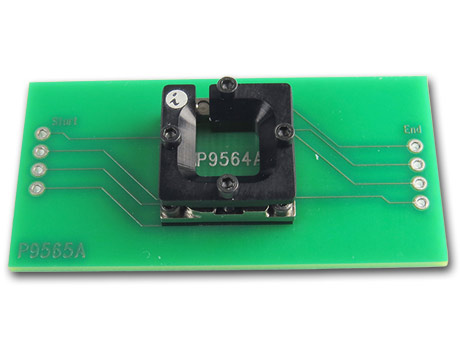
BGA Sockets with side access holes
Some of the applications need data rate such as 50Gbps. General rule of thumb translates 50Gbps into 75GHz bandwidth. Ironwood’s GT sockets use innovative elastomer interconnect technology that delivers low signal loss (-1dB at 94GHz) and supports BGA packages with pitches down to 0.2mm. GT is a new elastomer technology that has silver particles held in a conductive column like buttons which are embedded in a non-conductive polymer substrate on a proper pitch that provides high compliance and extreme temperature ranges (-55C to +160C). Life cycle is very similar to SG elastomer. GT elastomer needs torque tool as well for vertical compression force application. Example GT elastomer BGA socket with open top lid is shown in Figure 3.
Typical specifications for the GT interconnect include:
- 94 GHz Bandwidth
- 0.04 to 0.06nH Self Inductance
- 0.003 to 0.024nH Mutual Inductance
- 0.006 to 0.012pF Mutual Capacitance
- Less than 30 mOhms Contact Resistance
- -55C to +160C
- 5 Amps per pin
- 50-80 grams per pin
- 1000 to 2000 Insertions
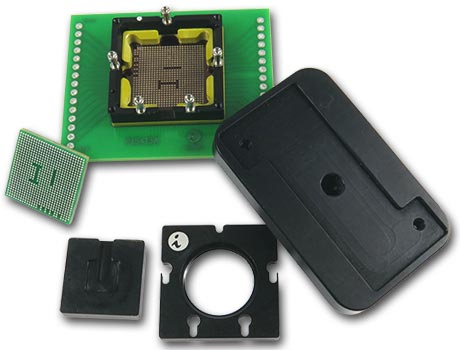
GT Sockets
Some of the applications need data rate such as 50Gbps. General rule of thumb translates 50Gbps into 75GHz bandwidth. Ironwood’s GT sockets use innovative elastomer interconnect technology that delivers low signal loss (-1dB at 94GHz) and supports BGA packages with pitches down to 0.2mm. GT is a new elastomer technology that has silver particles held in a conductive column like buttons which are embedded in a non-conductive polymer substrate on a proper pitch that provides high compliance and extreme temperature ranges (-55C to +160C). Life cycle is very similar to SG elastomer. GT elastomer needs torque tool as well for vertical compression force application. Example GT elastomer BGA socket with open top lid is shown in Figure 3.
Typical specifications for the GT interconnect include:
- 94 GHz Bandwidth
- 0.04 to 0.06nH Self Inductance
- 0.003 to 0.024nH Mutual Inductance
- 0.006 to 0.012pF Mutual Capacitance
- Less than 30 mOhms Contact Resistance
- -55C to +160C
- 5 Amps per pin
- 50-80 grams per pin
- 1000 to 2000 Insertions
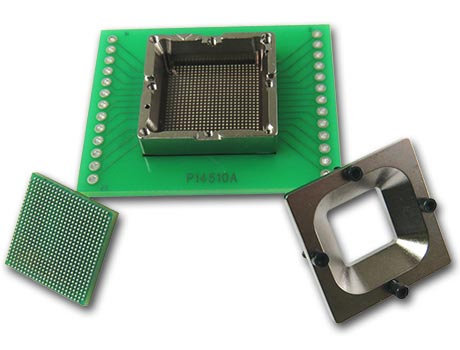
elastomer (GT) contact technology
Open Top QFP Sockets
When the applications demand thermal requirement, Ironwood’s BGA socket uses stamped spring pin (SBT) contact technology. SBT BGA sockets can be mounted on the same footprint as SG or GT BGA sockets. SBT BGA sockets simplify lab and evaluation applications due to low cost and better electrical/mechanical performance than conventional pogo pin sockets. SBT Contact is a stamped contact with outside spring as well as inside leaf spring that provides a robust solution for Burn-in & Test applications.
Typical specifications for the SBT interconnect include:
- 7 to 31.7 GHz Bandwidth
- 0.88 to 0.98nH Self Inductance
- 0.06 to 0.3nH Mutual Inductance
- 0.014 to 0.093pF Mutual Capacitance
- Less than 50 mOhms Contact Resistance
- -55C to +180C
- 4 to 8 Amps per pin
- 17 to 31 grams per pin
- 50,000 to 500,000 Insertions
SBT QFP sockets are typically designed with clamshell lid for easy open and close. Compression plate is integrated to the clamshell lid. No torque tool is needed. Force is applied by the integrated compression spring, a built in stop position prevents from over compression. Example SBT QFP socket with central open clamshell lid is shown in Figure 4.
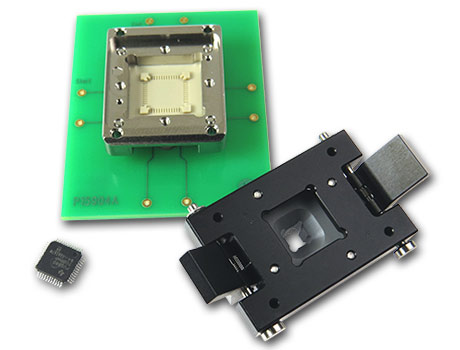
stamped spring pin (SBT) contact technology
Open Top BGA Sockets Air Flow Channel
Open top BGA/QFP socket is used for two reasons. One is to place a thermo couple from the top and access the case temperature of the BGA. The second reason is to use with thermal chamber where hot air is forced through the top. This will maintain case at specific temperature to verify the device is functioning properly at the temperature. Hot air from the top escapes out through the air flow channel designed in the compression plate of BGA socket. Below BGA socket (Figure 5) using SBT contact shows such an example.
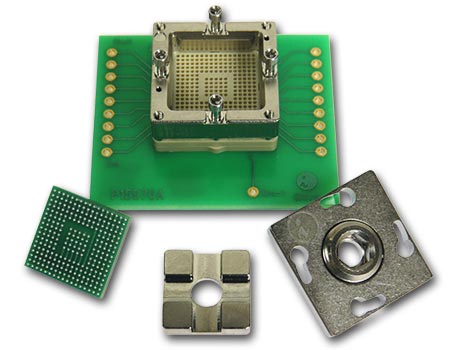
Open Top BGA Sockets MCMs
Many of the applications demand probing top side of the module. Figure 6 shows such an example open top BGA socket for IC modules. Users typically access miniature components on the top side during qualification test process. This BGA socket uses double latch mechanism and applies pressure on the edges of IC module leaving the central area for probing.
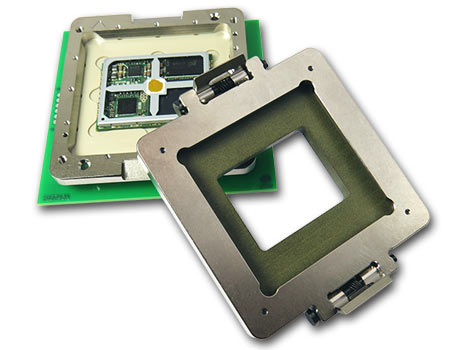
Open Top BGA Sockets Panel Arrays
Figure 7 is another example showing SBT open top BGA socket designed for testing PCB panels which contains an array of 2×2 devices.
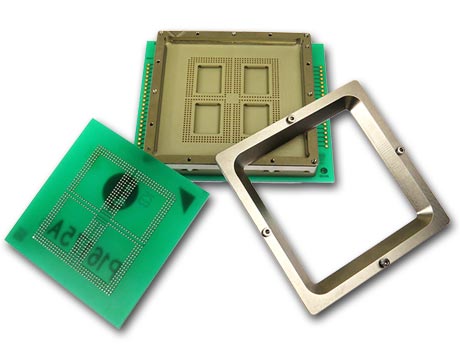
Open Top BGA Sockets Multiple Compartments
Top side opening can be customized based on modules. Figure 8 shows two chamber opening BGA socket using SBT contact technology.
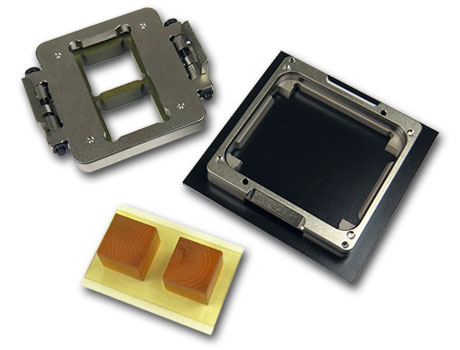
Open Top BGA Sockets Cam Actuated Levers
A typical BGA chip life is exemplified by bath tub curve. Because of inherent nature of BGA manufacturing processes, few percentage of BGAs fail very early in their life and the failure is very minimal during its life time and then failure percentage goes up at end of their life. Burn-in tests are conducted to screen those early failures. Typical burn-in test includes testing BGA device at 125C for 8 hrs. BGA sockets used for these applications have to be robust with no manual force application. Figure 9 shows a BGA socket with SBT contact for burn-in application. It also features a spring loaded lid actuated by cam lever. This means when the lid is closed, proper force is applied and it is not affected by temperature variation due to locking mechanism from cam lever. This is necessary for burn-in application as millions of devices have to go through this phase for screening early failures.
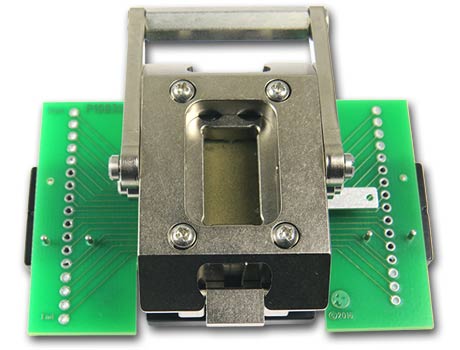
Open Top BGA Sockets using silver ball matrix elastomer
After passing burn-in test, these BGAs go through functional test which is often called production test. Since function is verified at this stage, bandwidth and current capacity requirements ranked high. This means a high speed BGA socket is needed to accomplish this phase of testing. Since millions of devices are being tested, higher the insertion/extraction cycle count, lower the overall cost of test is a must. This means BGA socket should test hundreds of thousands of devices. This unique situation calls for a high speed and high cycle count BGA socket. Ironwood’s SMP BGA socket uses silver ball matrix contact technology with a protective plunger matrix (a gold plated copper cylinder) that sits on top of the conductive columns. This plunger matrix protects the conductive column from contamination from various solder ball interfaces due to high cycle count. A quickly replaceable plunger matrix enables minimal downtime during final production test. Silver ball matrix elastomer accommodates high speed >40GHz. In addition to these electrical requirements, BGA socket design has to be compatible with handler which mechanically loads BGAs into the socket while the tester is performing functional verification. Figure 10 shows a SMP BGA socket with open top lid for manual set up. Once the tester is set to test, the manual open top lid is removed and handler starts loading devices as per programmed intervals.
Typical specifications for the SMP interconnect include:
- >40 GHz Bandwidth
- 0.1 to 0.14nH Self Inductance
- 0.017 to 0.031nH Mutual Inductance
- 0.004 to 0.01pF Mutual Capacitance
- Less than 30 mOhms Contact Resistance
- -55C to +155C
- 4 Amps per pin
- 50 to 80 grams per pin
- 500,000 Insertions
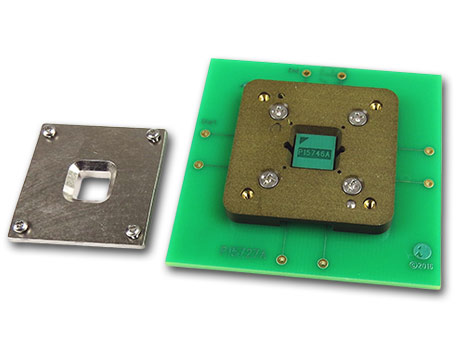
Open Top QFN Sockets for camera modules
Another example of open top production socket utilizes stamped spring pins which have durability of 500K cycles. Below picture (Figure 11) exemplifies QFN module socket. QFN module has optical IC in the middle which needs to be activated through light source during test process. This socket is good for automated test as the handler presses on both sides to open it. IC is dropped inside the socket cavity. When handler releases the pressure on two side handles, IC is compressed against the spring pin thereby connected to the target system for test.
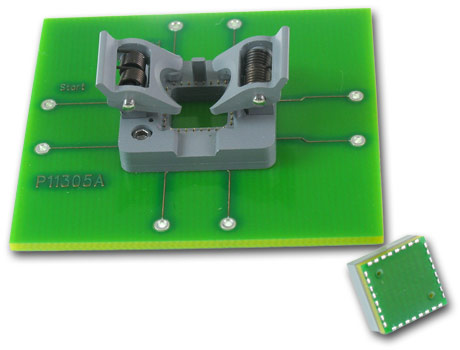
BGA Sockets with custom insulation plates
BGA sockets need vertical force which connects BGAs to elastomer or spring pins which in turn connects to the target PCB pads. Since the force applied varies due to pin count, pitch, contact technology used a back support plate called stiffener is always used in almost all of the BGA socket design. In most cases, the backside of target PCB contains capacitors and resistors. Since the stiffener plate cannot go on top of the components, a custom insulation plate with cavities milled for those capacitors and resistors has to be designed. The insulation plate sandwiches between the back support plate and the target PCB. Figure 12 shows an example BGA socket with insulation plate.
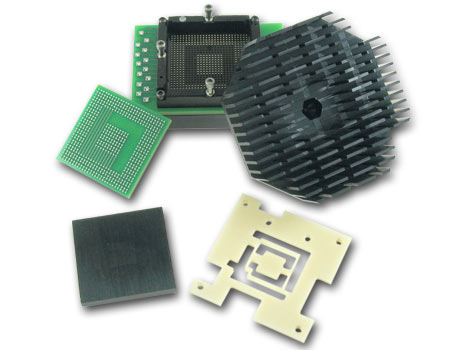
Five Post Back Plate
Alternatively, a five post back plate is used in the BGA socket wherein the post locations are predefined as keep out zone for the bottom side PCB. Figure 13 shows back plate that has protruded post location that allows capacitors and resistors to be populated in between the post location.
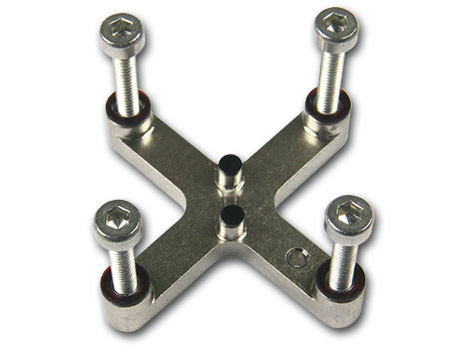
Open Top QFP Sockets with double latch lids
Another example shown (Figure 14) below is open top QFP socket mounted on probe board which brings the signal to test pins for debugging.
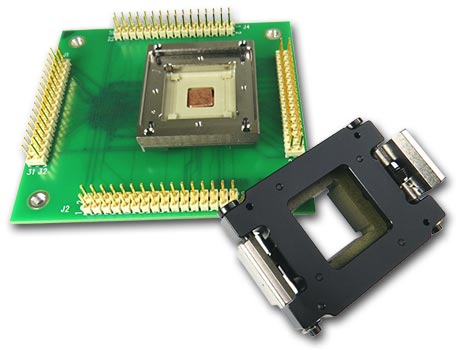
Custom open top BGA/QFN sockets to accommodate rectangular body shapes, odd sizes, and devices with pitches down to 0.3mm can be developed in short lead time. BGA package specifications can vary widely between manufacturers. We have found that it is most effective for us to ask customers for information about the specific device to be tested in the BGA socket and then provide a quote. You can fill the form with required information or call us at 1-800-404-0204.